Piloting an Unmanned Aerial Vehicle to Explore the Floristic Variations of Inaccessible Cliffs along Island Coasts
Abstract
:1. Introduction
2. Materials and Methods
2.1. Study Area
2.2. Study Design for UAV Data Acquisition
2.3. Flora Taxa Identification and Categorization

2.4. Data Analysis
3. Results
3.1. Coastal Cliff Flora Taxa, Incidence, and Dominance
3.2. Patterns Related to Coastal Cliff Aspect and Elevation
4. Discussion
4.1. Floristic Variabilities under Differing Coastal Cliff Aspect and Elevation
4.2. Implications and Future Research Requirements
5. Conclusions
Supplementary Materials
Author Contributions
Funding
Data Availability Statement
Acknowledgments
Conflicts of Interest
Appendix A
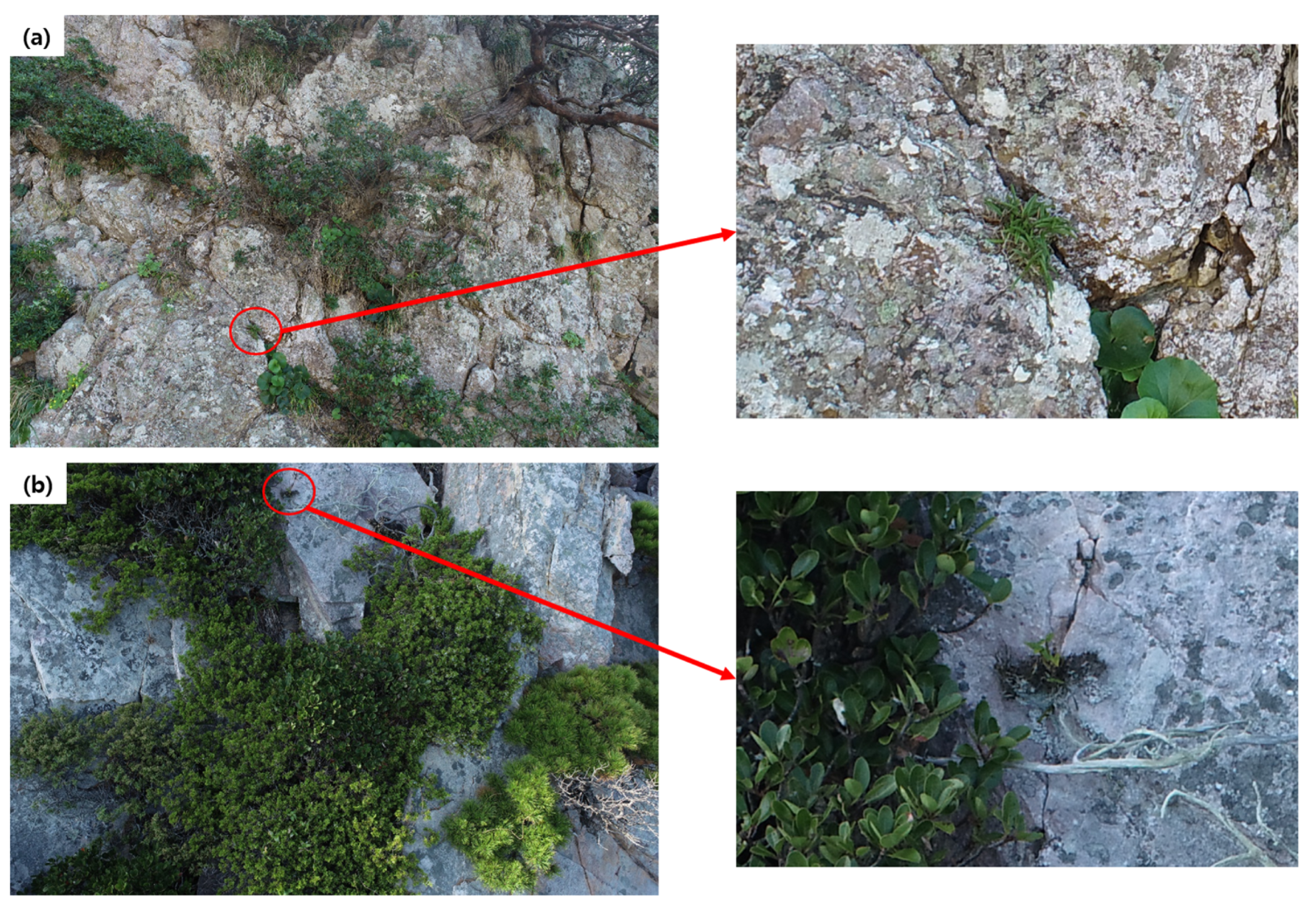
References
- Goldsmith, F.B. Interaction (competition) studies as a step towards the synthesis of sea-cliff vegetation. J. Ecol. 1978, 66, 921–931. [Google Scholar] [CrossRef]
- Panitsa, M.; Kokkoris, I.P.; Kougioumoutzis, K.; Kontopanou, A.; Bazos, I.; Strid, A.; Dimopoulos, P. Linking taxonomic, phylogenetic and functional plant diversity with ecosystem services of cliffs and screes in Greece. Plants 2021, 10, 992. [Google Scholar] [CrossRef] [PubMed]
- Wilson, J.B.; Cullen, C. Coastal cliff vegetation of the Catlins region Otago, South Island, New Zealand. New Zealand J. Bot. 1986, 24, 567–574. [Google Scholar] [CrossRef]
- Cámara-Leret, R.; Frodin, D.G.; Adema, F.; Anderson, C.; Appelhans, M.S.; Argent, G.; Guerrero, S.A.; Ashton, P.; Baker, W.J.; Barfod, A.S.; et al. New Guinea has the world’s richest island flora. Nature 2020, 584, 579–583. [Google Scholar] [CrossRef]
- Jung, S.H.; Kim, A.R.; Lim, B.S.; Seol, J.W.; Lee, C.S. Spatial distribution of vegetation along the environmental gradient on the coastal cliff and plateau of Janggi peninsular (Homigot), southeastern Korea. J. Ecol. Environ. 2019, 43, 14. [Google Scholar]
- Caperta, A.D.; Espírito-Santo, M.D.; Silva, V.; Ferreira, A.; Paes, A.P.; Róis, A.S.; Costa, J.C.; Arsénio, P. Habitat specificity of a threatened and endemic, cliff-dwelling halophyte. AOB Plants 2014, 6, plu032. [Google Scholar] [CrossRef] [Green Version]
- Strumia, S.; Buonanno, M.; Aronne, G.; Santo, A.; Santangelo, A. Monitoring of plant species and communities on coastal cliffs: Is the use of unmanned aerial vehicles suitable? Diversity 2020, 12, 149. [Google Scholar] [CrossRef] [Green Version]
- Davis, P.H. Cliff vegetation in the eastern Mediterranean. J. Ecol. 1951, 39, 63–93. [Google Scholar] [CrossRef]
- Randall, R.E. Vegetation and environment on the Barbados coast. J. Ecol. 1970, 58, 155–172. [Google Scholar] [CrossRef]
- Boggess, L.M.; Walker, G.L.; Madritch, M.D. Cliff flora of the Big South Fork National River and Recreation Area. Nat. Areas J. 2017, 37, 200–211. [Google Scholar] [CrossRef]
- Covy, N.; Benedict, L.; Keeley, W.H. Rock climbing activity and physical habitat attributes impact avian community diversity in cliff environments. PLoS ONE 2019, 14, e0209557. [Google Scholar] [CrossRef]
- March-Salas, M.; Moreno-Moya, M.; Palomar, G.; Tejero-Ibarra, P.; Haeuser, E.; Pertierra, L.R. An innovative vegetation survey design in Mediterranean cliffs shows evidence of higher tolerance of specialized rock plants to rock climbing activity. Appl. Veg. Sci. 2018, 21, 289–297. [Google Scholar] [CrossRef]
- Reckling, W.; Mitasova, H.; Wegmann, K.; Kauffman, G.; Reid, R. Efficient drone-based rare plant monitoring using a species distribution model and AI-based object detection. Drones 2021, 5, 110. [Google Scholar] [CrossRef]
- Zhou, H.; Zhu, J.; Li, J.; Xu, Y.; Li, Q.; Yan, E.; Zhao, S.; Xiong, Y.; Mo, D. Opening a new era of investigating unreachable cliff flora using smart UAVs. Remote Sens. Ecol. Conserv. 2021, 7, 638–648. [Google Scholar] [CrossRef]
- La Vigne, H.; Charron, G.; Rachiele-Tremblay, J.; Rancourt, D.; Nyberg, B.; Desbiens, A.L. Collecting critically endangered cliff plants using a drone-based sampling manipulator. Sci. Rep. 2022, 12, 14827. [Google Scholar] [CrossRef]
- Li, M.; Yan, E.; Zhou, H.; Zhu, J.; Jiang, J.; Mo, D. A novel method for cliff vegetation estimation based on the unmanned aerial vehicle 3D modeling. Front. Plant Sci. 2022, 13, 1006795. [Google Scholar] [CrossRef]
- Duffy, J.P.; Cunliffe, A.M.; DeBell, L.; Sandbrook, C.; Wich, S.A.; Shutler, J.D.; Myers-Smith, I.H.; Varela, M.R.; Anderson, K. Location, location, location: Considerations when using lightweight drones in challenging environments. Remote Sens. Ecol. Conserv. 2018, 4, 7–19. [Google Scholar] [CrossRef]
- Kim, S.; Park, H.J.; Lee, C.W.; Kim, N.Y.; Hwang, J.E.; Lee, B.D.; Park, H.B.; An, J.; Baek, J.H. Endangered plant species under differing anthropogenic interventions: How to preserve Pterygopleurum neurophyllum in Wondong wetland? PeerJ 2022, 10, e14050. [Google Scholar] [CrossRef]
- Rominger, K.R.; DeNittis, A.; Meyer, S.E. Using drone imagery analysis in rare plant demographic studies. J. Nat. Conserv. 2021, 62, 126020. [Google Scholar] [CrossRef]
- Sun, Z.; Wang, X.; Wang, Z.; Yang, L.; Xie, Y.; Huang, Y. UAV as remote sensing platforms in plant ecology: Review of applications and challenges. J. Plant Ecol. 2021, 14, 1003–1023. [Google Scholar] [CrossRef]
- Villoslada, M.; Bergamo, T.F.; Ward, R.D.; Burnside, N.G.; Joyce, C.B.; Bunce, R.G.H.; Sepp, K. Fine scale plant community assessment in coastal meadows using UAV based multispectral data. Ecol. Indic. 2020, 111, 105979. [Google Scholar] [CrossRef]
- Clark, A.; Moorman, B.; Whalen, D.; Fraser, P. Arctic coastal erosion: UAV-SfM data collection strategies for planimetric and volumetric measurements. Arct. Sci. 2021, 7, 605–633. [Google Scholar] [CrossRef]
- Gilham, J.; Barlow, J.; Moore, R. Detection and analysis of mass wasting events in chalk sea cliffs using UAV photogrammetry. Eng. Geol. 2019, 250, 101–112. [Google Scholar] [CrossRef] [Green Version]
- Kong, X. Identifying geomorphological changes of coastal cliffs through point cloud registration from UAV. Remote Sens. 2021, 13, 3152. [Google Scholar] [CrossRef]
- Irl, S.D.H.; Harter, D.E.V.; Steinbauer, M.J.; Puyol, D.G.; Fernández-Palacios, J.M.; Jentsch, A.; Beierkuhnlein, C. Climate vs. topography—Spatial patterns of plant species diversity and endemism on a high-elevation island. J. Ecol. 2015, 103, 1621–1633. [Google Scholar] [CrossRef]
- Boggess, L.M.; Harrison, G.R.; Bishop, G. Impacts of rock climbing on cliff vegetation: A methods review and best practices. Appl. Veg. Sci. 2021, 24, e12583. [Google Scholar] [CrossRef]
- Jang, Y.J.; Park, J.S.; Lee, J.S.; Lee, J.Y.; Choi, B.-H. Re-examination of the vascular plants on Hongdo Island, Korea. Korean J. Plant Taxon. 2021, 52, 205–249, (In Korean with English Abstract). [Google Scholar] [CrossRef]
- Kim, H.J.; Shin, J.K.; Lee, C.H.; Yun, C.W. Phytosociological community type classification and stand structure in the forest vegetation of Hongdo Island, Jeollanam-do Province. J. Korean Soc. For. Sci. 2018, 107, 245–257, (In Korean with English Abstract). [Google Scholar]
- Braun-Blanquet, J. Plant Sociology. The Study of Plant Communities; McGraw-Hill Book Co., Inc.: New York, NY, USA, 1932; p. 439. [Google Scholar]
- Lee, W.T. Standard Illustrations of Korean Plants; Academy Press: Seoul, Republic of Korea, 1996; p. 624. (In Korean) [Google Scholar]
- Lee, T.B. Coloured Flora of Korea; Hyangmun Publ. Co., Ltd.: Seoul, Republic of Korea, 2003; p. 1928. (In Korean) [Google Scholar]
- Noh, N.J.; Son, Y.; Koo, J.W.; Seo, K.W.; Kim, R.H.; Lee, Y.Y.; Yoo, K.S. Comparison of nitrogen fixation for north- and south-facing Robinia pseudoacacia stands in central Korea. J. Plant Biol. 2010, 53, 61–69. [Google Scholar] [CrossRef]
- Zotz, G.; Hietz, P. The physiological ecology of vascular epiphytes: Current knowledge, open questions. J. Exp. Bot. 2001, 52, 2067–2078. [Google Scholar] [CrossRef]
- Ge, J.; Xie, Z. Geographical and climatic gradients of evergreen versus deciduous broad-leaved tree species in subtropical China: Implications for the definition of the mixed forest. Ecol. Evol. 2017, 7, 3636–3644. [Google Scholar] [CrossRef]
- Earlie, C.; Masselink, G.; Russell, P. The role of beach morphology on coastal cliff erosion under extreme waves. Earth Surf. Process. Landf. 2018, 43, 1213–1228. [Google Scholar] [CrossRef] [Green Version]
- Alessio, P.; Keller, E.A. Short-term patterns and processes of coastal cliff erosion in Santa Barbara, California. Geomorphology 2020, 353, 106994. [Google Scholar] [CrossRef]
- Bergillos, R.J.; Rodriguez-Delgado, C.; Cremades, J.; Medina, L.; Iglesias, G. Multi-criteria characterization and mapping of coastal cliff environments: A case study in NW Spain. Sci. Total Environ. 2020, 746, 140942. [Google Scholar] [CrossRef]
- Lee, E.M. Coastal cliff behaviour: Observations on the relationship between beach levels and recession rates. Geomorphology 2008, 101, 558–571. [Google Scholar] [CrossRef]
- Kogure, T. Rocky coastal cliffs reinforced by vegetation roots and potential collapse risk caused by sea-level rise. Catena 2022, 217, 106457. [Google Scholar] [CrossRef]
- Peña-Lastra, S.D.L.; Gómez-Rodríguez, C.; Pérez-Alberti, A.; Torre, F.; Otero, X.L. Effects of a yellow legged gull (Larus michahellis) colony on soils and cliff vegetation in the Atlantic Island of Galicia National Park (NW Spain). Catena 2021, 199, 105115. [Google Scholar] [CrossRef]
- Sawtschuk, J.; Bioret, F.; Gallet, S. Spontaneous succession as a restoration tool for maritime cliff-top vegetation in Brittany, France. Restor. Ecol. 2010, 18, 273–283. [Google Scholar] [CrossRef]
- Augusto, J.; Martins, C.; Marcato Junior, J.; Pätzig, M.; Sant’Ana, D.A.; Pistori, H.; Liesenberg, V.; Eltner, A. Identifying plant species in kettle holes using UAV images and deep learning techniques. Remote Sens. Ecol. Conserv. 2022. Published online. [Google Scholar] [CrossRef]
- Niwa, H.; Hirata, T. A new method for surveying the world’s smallest class of dragonfly in wetlands using unoccupied aerial vehicles. Drones 2022, 6, 427. [Google Scholar] [CrossRef]
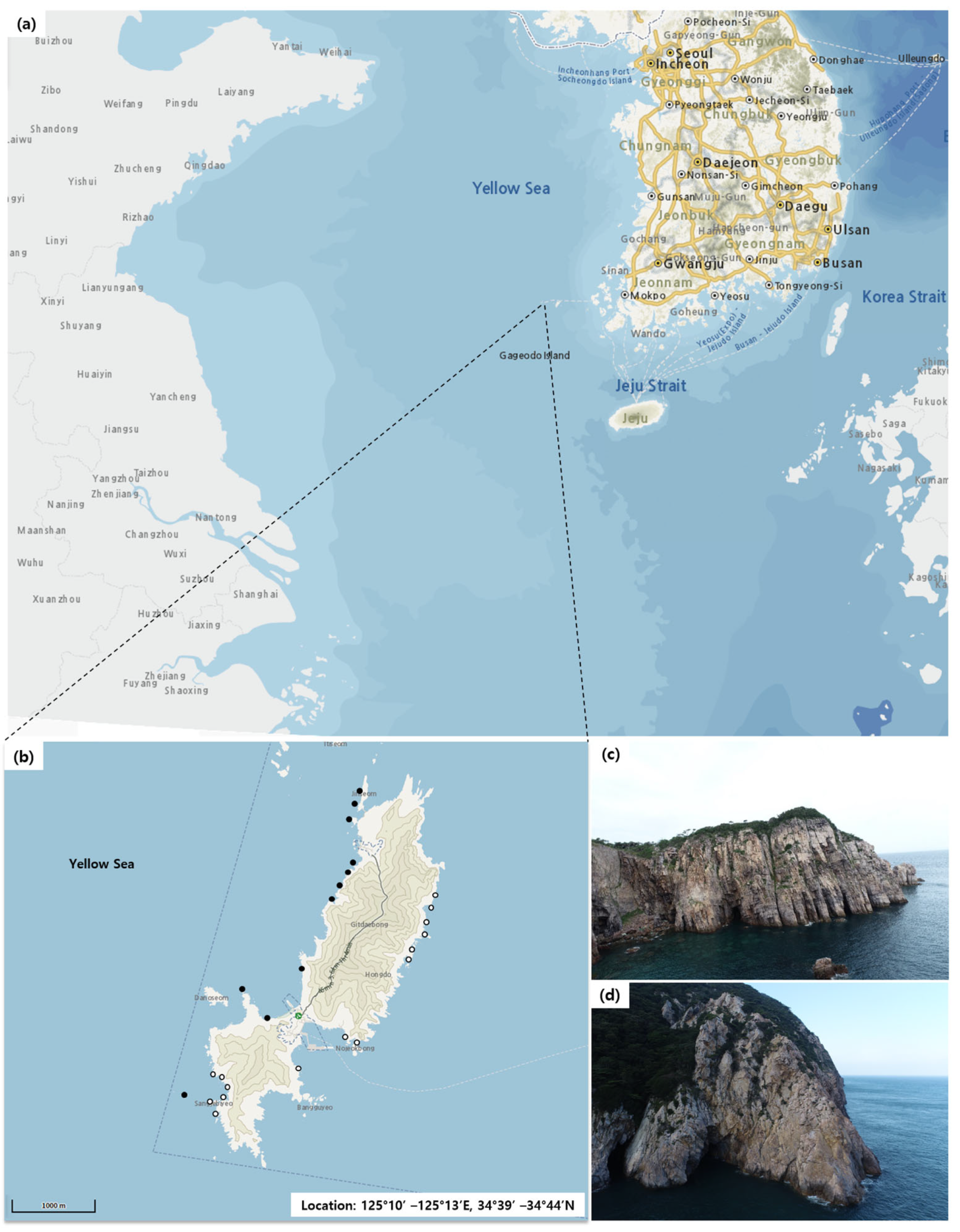
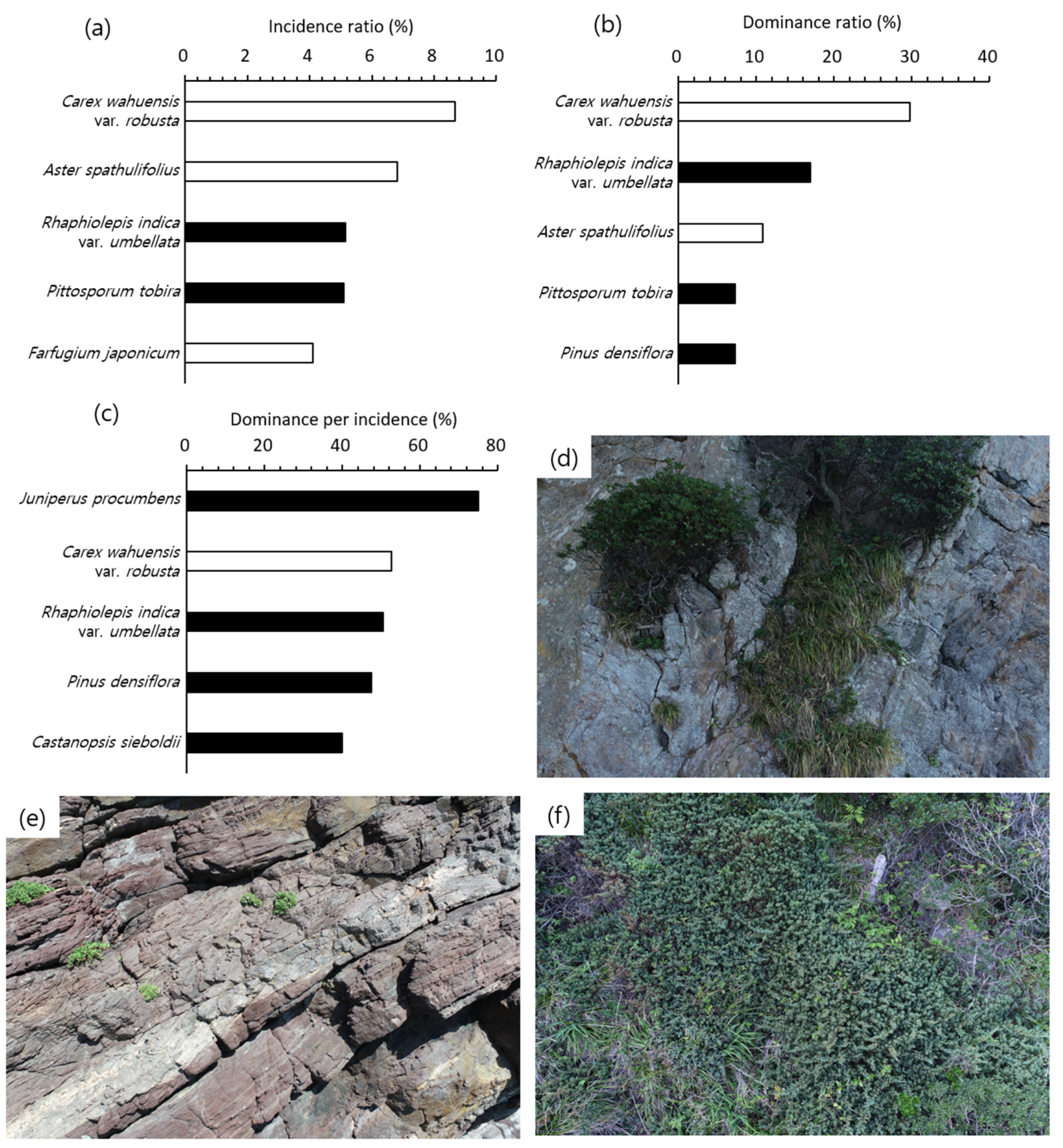
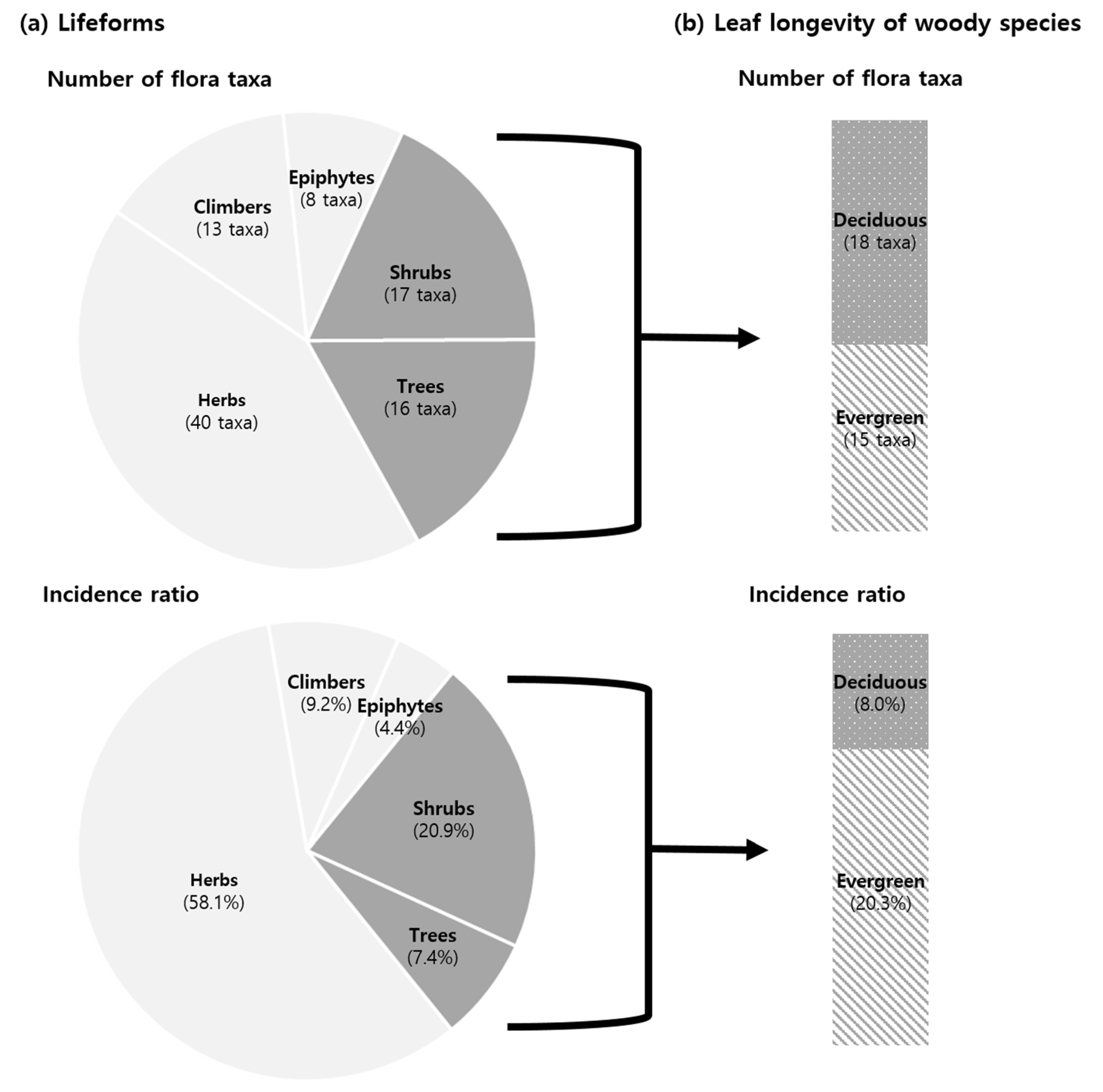

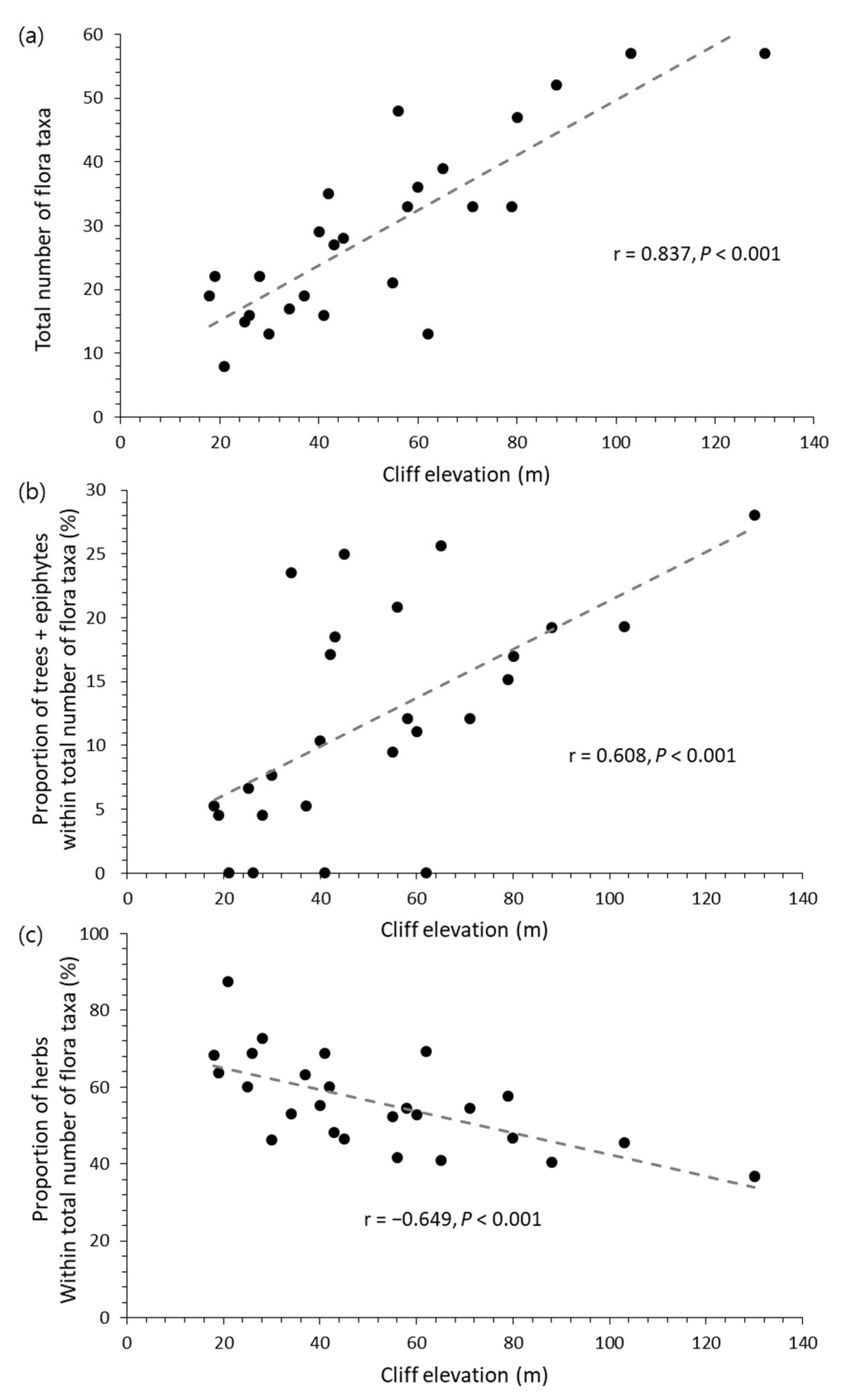
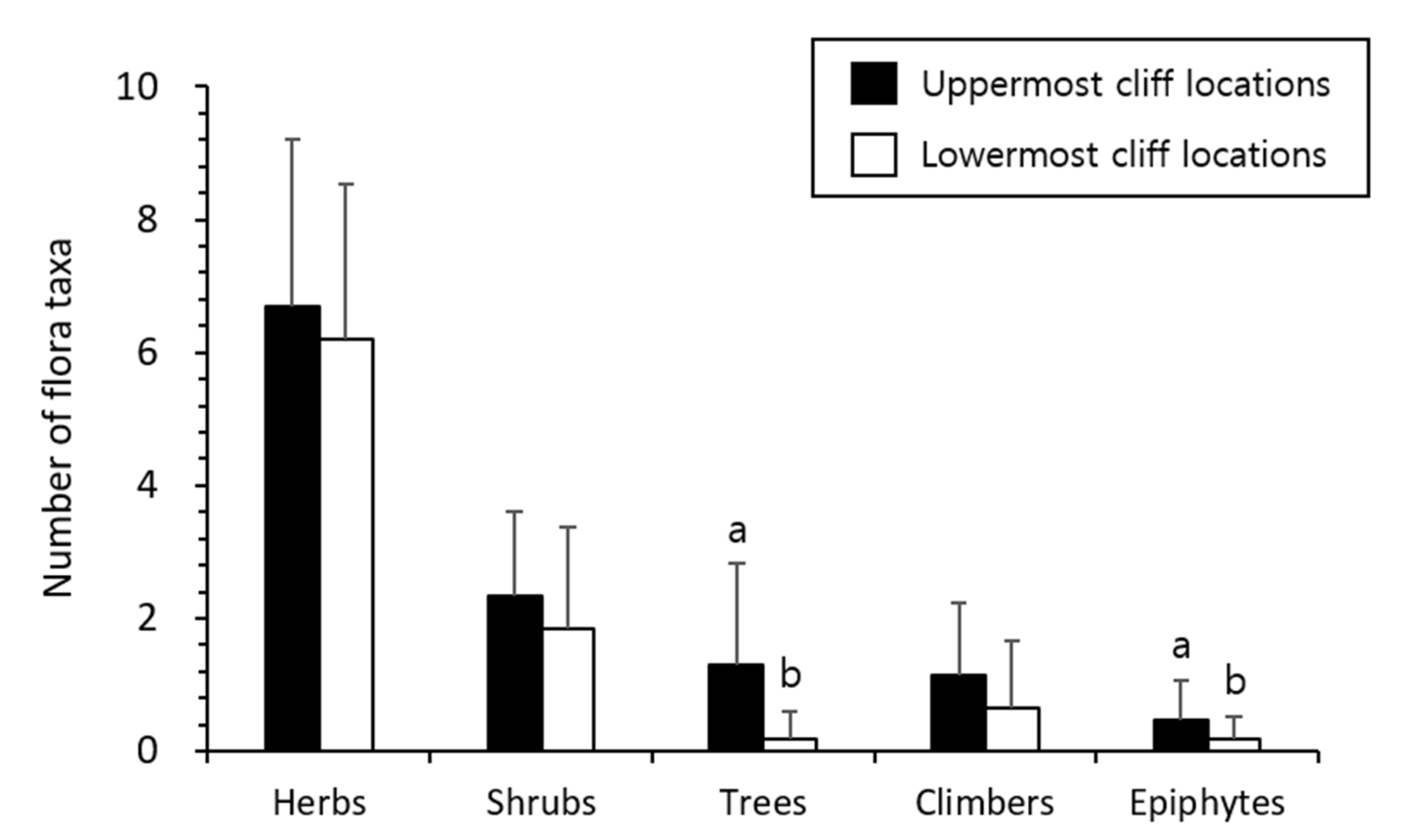
| Cliff Type | Characteristics | Number of Cliffs | Cliff Elevation (m) | ||
|---|---|---|---|---|---|
| Average a | Minimum | Maximum | |||
| Type-N | Directly exposed to cold, dry wind gusts in winter (northwestern aspect of the study area) | 11 | 55 (28) | 18 | 103 |
| Type-S | Sheltered from the wind gust in winter (facing southeast or surrounded by the mountainous bay) | 15 | 50 (22) | 28 | 130 |
Disclaimer/Publisher’s Note: The statements, opinions and data contained in all publications are solely those of the individual author(s) and contributor(s) and not of MDPI and/or the editor(s). MDPI and/or the editor(s) disclaim responsibility for any injury to people or property resulting from any ideas, methods, instructions or products referred to in the content. |
© 2023 by the authors. Licensee MDPI, Basel, Switzerland. This article is an open access article distributed under the terms and conditions of the Creative Commons Attribution (CC BY) license (https://creativecommons.org/licenses/by/4.0/).
Share and Cite
Kim, S.; Lee, C.W.; Park, H.-J.; Lee, B.-D.; Kim, N.Y.; Hwang, J.E.; Park, H.B.; An, J.; Baek, J. Piloting an Unmanned Aerial Vehicle to Explore the Floristic Variations of Inaccessible Cliffs along Island Coasts. Drones 2023, 7, 140. https://doi.org/10.3390/drones7020140
Kim S, Lee CW, Park H-J, Lee B-D, Kim NY, Hwang JE, Park HB, An J, Baek J. Piloting an Unmanned Aerial Vehicle to Explore the Floristic Variations of Inaccessible Cliffs along Island Coasts. Drones. 2023; 7(2):140. https://doi.org/10.3390/drones7020140
Chicago/Turabian StyleKim, Seongjun, Chang Woo Lee, Hwan-Joon Park, Byoung-Doo Lee, Nam Young Kim, Jung Eun Hwang, Hyeong Bin Park, Jiae An, and JuHyoung Baek. 2023. "Piloting an Unmanned Aerial Vehicle to Explore the Floristic Variations of Inaccessible Cliffs along Island Coasts" Drones 7, no. 2: 140. https://doi.org/10.3390/drones7020140






